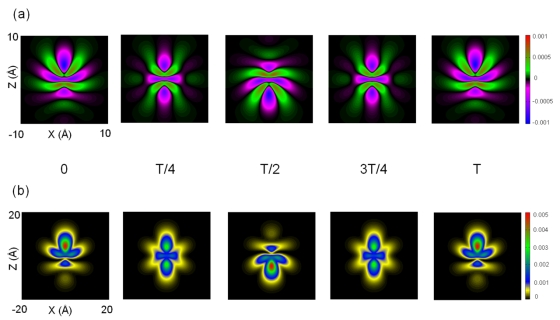Electrons snapped by X-rays
Electrons are the glue that keeps atoms in matter together, and their motion plays a key role in the function and transformation of materials. During complex chemical and biological reactions, electrons undergo ultrafast rearrangements, determining the later properties of the generated substance or material.
© 2013 American Physical Society
One of the key characteristics of the new X-ray lasers like FLASH or European X-ray Free Electron Laser (XFEL) is to trace these ultrafast electronic rearrangements in detail in order to understand and eventually change the behaviour of the reacting partners to develop new functional materials. For ordinary synchrotron light sources, this motion of electrons has always been too fast for taking an image. But with the intense and ultrashort light pulses of X-ray lasers, these facilities should be able to freeze frame the electronic motion during a chemical reaction, even if the sample consists only of a handful of molecules.
But such high-speed films do not only call for new detectors and equipment, it also needs new theoretical approaches: How can one describe and interpret the interaction of ultrashort and highly intense X-ray with an non-stationary electronic system? And how can one be sure that the intense laser pulse does only probe the current arrangement and does not disturb the sample too much to destroy the measurement?
For this work, we simulated a disordered electronic system rearranging in few femtoseconds time, the usual timescale for electronic movements. In this simulation, the incoming light pulse as a quantum packet interacting with the electrons and demonstrated that the laser pulses are really able to shoot different states of the ultrafast electronic motions. On the second hand, we show that the problem of light-induced changes during shooting the motion can be overcome by taking snapshots using the phase variation of x-rays. Phase contrast imaging is a very common method for imaging samples by synchrotron light. It makes use of the fact that interaction of light with matter does not only change the intensity of the light wave but also the phase. The phase difference of the transmitted light and the scattered light can be detected and contains the information of the sample´s structure. Although this is a very basic theoretical investigation, our approach opens the possibility, for the first time, to take snapshots of electronic motion at different instants and make a movie of electrons. Once the method can be applied in experiments, it will shed light on, and thus improve our understanding of ultrafast processes in nature.
Phys. Rev. Lett. 110 (2013) 137403
http://prl.aps.org/abstract/PRL/v110/i13/e137403
